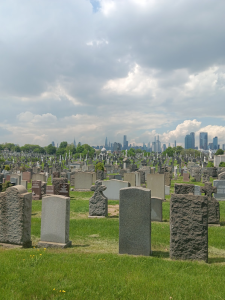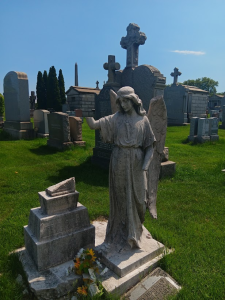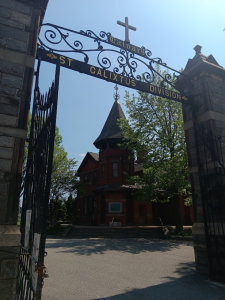
In the shadow of the Kosciuszko Bridge, you’ll find more than greenspace and fun times—just across Newtown Creek, in Queens County, is the largest cemetery in New York City: Old Calvary Cemetery. More dead people than living people can be found in the city’s most populous borough; Calvary alone has nearly three million burials.
Calvary Cemetery has its own rich and fascinating backstory, tied firmly to the history of New York City’s impoverished Italian, Irish and German immigrants. Its age makes it a glorious showcase of some of the most beautifully carved tombstones and mausolea to be found in the state, alongside its large number of celebrities and notables interred there. Most interestingly, Google Maps doesn’t appear to know it exists.
In the words of local Newtown Creek historian Mitch Waxman, the tale of Old Calvary is one of perpetual change. When it was opened, most of the city skyline was comprised of tenements, church steeples, and the occasional courthouse dome; by the time it was filled, the Empire State Building was being built. The practice in the early 19th century was to bury the dead of Manhattan in local church graveyards, or even in the dirt floor of the basement of the deceased’s house. After a series of cholera outbreaks, the city began doubting the wisdom of this practice and mandated the creation of a series of rural cemeteries, “out in the country,” in Mr. Waxman’s words, which at the time meant Queens County.
Under the leadership of Archbishop John “Dagger John” Hughes, an old and venerable Dutch homestead called the Alsop farm in Queens was bought for the construction of Calvary Cemetery. An army of Irish laborers descended on site in 1845 and proceeded to level the ground, landscape the terrain, and install a vast sewer system draining into Newtown Creek. By July 1848 the cemetery was ready to receive its first burial, a washerwoman named Esther Ennis, who died, Mr. Waxman says, “Of a broken heart.” The following month, the site was officially consecrated by His Excellency. The graveyard takes its name from Mount Calvary, also known as Golgotha, the place of the skull, where Christ was crucified and where legend says Adam’s skull is buried. Millions of Catholic Italians, Germans, Irish and other ethnicities would be buried there in the coming years.

Numerous Catholic Civil War dead were interred in Calvary. In 1863, the city bought part of Calvary from the Archdiocese of New York for the construction of a monument honoring Civil War soldiers, later finished in 1866. Only a year later, the cemetery was filled. The archdiocese bought more land and expanded, forming Second, Third and Fourth Calvary Cemetery several blocks east of Calvary Cemetery, now called Old or First Calvary.
Over the years, many of the stones appear to have melted, and numerous statues of the Virgin, angels, and the Christ Child appear to have been warped. A copper refining plant once sat across Newtown Creek in Greenpoint, spewing fumes across the water that induced decay in the statues. The archdiocese ultimately sued the refining plant and won a case against them in the early 20th century. Today, Calvary is one of the most prestigious cemeteries in the city, with burials continuing in the other three sections.
Calvary contains the costliest real estate in Queens; one plot in Calvary can reportedly cost as much as $600,000. Some of the city’s most notable citizens rest in Old Calvary, among them Patrick Jerome “Battle-Axe” Gleason, the last mayor of Long Island City; three Robert F. Wagners of political fame; Steve Brodie, who supposedly jumped from the Brooklyn Bridge and survived; and many now-forgotten Tammany Hall bosses. Numerous other gangsters are buried in Calvary as well, such as the Artichoke King, Lupo the Wolf, Sonny Black, the Clutch Hand, and Joe Diamond.
Joe Masseria, the former head of the Genovese crime family whose death led to the formation of the Five Families, is also buried in Calvary. Fresh flowers are always placed on his grave; the identity of his mysterious mourner is unknown. Anthony Arillotta, former Genovese family capo, asked around but was unable to find any information right away. “The only thing I can offer is that it would be Joe’s family putting the flowers there,” Mr. Arillotta said. “No Mafia family would participate in that.”
Aside from the stones and mausolea, St. Calixtus’s Chapel sits on Old Calvary’s grounds. The chapel has a large mausoleum underneath for the interment of religious sisters and brothers, nuns, and priests, which was recently rediscovered through the efforts of Mr. Waxman. Mr. Waxman is the former Newtown Creek Alliance’s group historian (among his numerous other titles) and provided most of the historical background for this article.
St. Calixtus’s takes its name from Pope Saint Calixtus, patron saint of cemetery workers. Prior to becoming bishop of Rome, Calixtus founded and maintained a cemetery that later bore his name on Rome’s outskirts. He ultimately became pope around A.D. 218 and served for four years before he was lynched by a Roman mob around A.D. 222.
Among the cemetery’s most notable living inhabitants are red-tailed hawks, as well as flocks of migrating birds, which take advantage of the greenspace several times a year. The Audubon Society makes occasional forays into the graveyard to quantify and observe said birds. Coneys, the type of rabbit Coney Island takes its name from, are also frequently seen. Even in this place of death, life finds a way to thrive.
If you’re trying to get to Old Calvary Cemetery, don’t use Google Maps. Searching “Calvary Cemetery” directs you to Second Calvary Cemetery, the more modern addition, bordered by Third and Fourth Calvary Cemeteries. Old Calvary Cemetery is on Greenpoint Avenue and can be reached by taking the B24 to the Greenpoint Ave/Gale Av stop, right by the main gates. Another entrance is located at Laurel Hill Boulevard and Review Avenue. Old Calvary is open every day from 9:00 a.m. to 4:30 p.m. Mass for the souls of the dead is celebrated every Saturday at 10:00 a.m. in the St. Calixtus Chapel.
When you visit, remember to always follow all cemetery rules and regulations, cooperate with staff and other personnel, and remain respectful of the dead, mourners, and other visitors.




